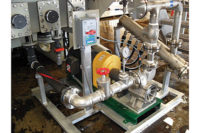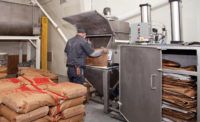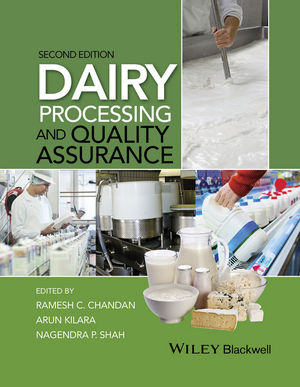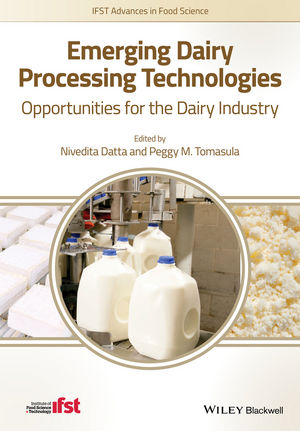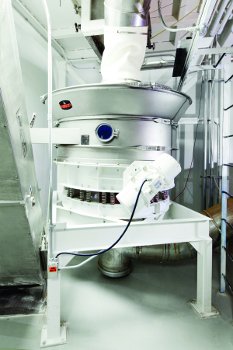Techniques
PBI finds a fluid bed processing system works most efficiently
A new food granulizing line fits a restricted space with circular fluid bed processor

The circular fluid bed processor consumes significantly less floor space than the rectangular fluid bed dryer originally considered.

Material before (left) and after being moisturized, agglomerated and dried in the circular fluid bed processor.

Powder enters the circular fluid bed processor through the top port. From the bottom, hot air is continuously blown upward through an enclosed circular screen on which the particles separate and fluidize. At timed intervals, liquids are added to the air stream to moisturize and agglomerate the particles, while the hot air continues to dry the material.



 SPEARFISH, SD—Precision Blending International's business consisted entirely of blending and milling dairy powders for food and dairy products until 2010, when a customer asked the company to produce an agglomerated blend of finely powdered raw material to improve its processability in food formulations.
SPEARFISH, SD—Precision Blending International's business consisted entirely of blending and milling dairy powders for food and dairy products until 2010, when a customer asked the company to produce an agglomerated blend of finely powdered raw material to improve its processability in food formulations.
"Agglomeration was new for us, requiring a third process line," says Dan Carlbom, owner and president.
The opportunity meant more business for PBI, but also the challenge of fitting a new line that includes equipment to moisturize, agglomerate and dry the material, in a plant of 27,000 sq ft (2,508 sq m). The process line—details of which Carlbom declines to disclose for competitive reasons—involved a fixed length of machinery and therefore limited size options for the drying equipment at the end of the line.
Footprint influenced fluid bed processor selection
Carlbom decided that a fluid bed processing system would work most efficiently, and had two choices of equipment. One was a conventional rectangular fluid bed dryer, which would have taken up a large amount of space due to its shape, structural elements, and weight. The other was a circular fluid bed processing system, which he purchased from Kason Corp. The circular type not only dries the resized protein powders efficiently, but with a 60 in. (1524 mm) diameter, takes up far less floorspace than a rectangular fluid bed system. “The unit fit where I wanted to put it,” Carlbom says.
Because the circular fluid bed processor is inherently more rigid that rectangular designs, materials of construction can be of downgauged, internal crossbraces eliminated, and gyratory motors downsized. Fewer weld seams and the absence of corners and internal cross braces also facilitate faster cleaning and changeover times.
The circular fluid bed processor can also be integrated with a heater, blower, ductwork, spray line, and control panel on a caster-mounted frame, allowing in-plant mobility and rapid setup.
Circular Fluid Bed Processor moisturizes, agglomerates, dries
At PBI, the circular fluid bed processor is configured to moisturize, agglomerate and then dry the powders.
Dairy proteins arrive at the plant in bulk bags that are discharged into the process through a grate that removes oversized agglomerates and foreign material.
Material enters the fluid bed processor through an intake port on top of the unit via an auger feeder and rotary valve. The heater, blower and ductwork route hot air upward through the enclosed circular screen on which the continuous air flow and vibration separate and fluidize individual particles, maximizing the surface area of material. The vibratory motion of the processor also serves to convey the material along a defined pathway for uniform processing on a "first in/first out" basis.
Liquids are added to the air stream at timed intervals to moisturize and agglomerate particles, and impart desired flow characteristics. “The powder starts out very fine, almost like talcum,” Carlbom says. As it moves through the process, particle sizes increase, improving flow, and solubility.
The hot air then dries the material to a preset moisture level. Once dry, the granules exit through the discharge port onto a conveyor, which transfers them to a packaging line for loading into 15 or 20 kg (33 or 44 lb) bags.
The process is continuous, although throughput varies by product. PBI has setpoints for different types of powder, and process rates vary from 500 to 2,000 lb (1,100 to 4,400 kg) per hour.
PBI purchased the fluid bed processing system from ABM Equipment Company Inc. of Portland, OR, a Kason representative. Carlbom says, "Kason provided PBI with a laboratory unit for onsite testing, which confirmed our decision to order the larger unit for full scale production.”
Carlbom says the unit works reliably, and meets a demanding production schedule of 12 hours per day, 5 to 6 days per week.
Looking for a reprint of this article?
From high-res PDFs to custom plaques, order your copy today!




